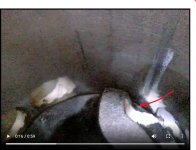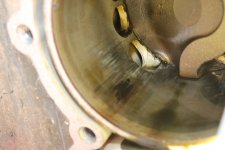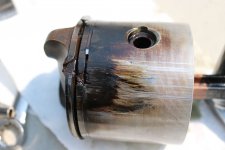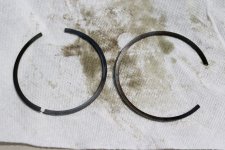History: My 1995 70HP Force has been dying at idle lately. It is difficult to get into gear, before it dies. Many times I have to use fast idle to start, even after it is warmed up. For cold start, fuel enrichment seems to be working properly. I increased the idle speed, which helped, but it still does not start and idle like it usually does. Using Frank A’s Carb and Timing tutorial, I planned to do the link and sync, then check/set idle and mixture. To start the process, I took the spark plugs out and decided it would a good time to check compression.
Compression Results: The readings were #1-135, #2-75, #3-145 psi. Adding oil in the #2 cylinder increased the pressure a little, up to 85 psi. Although, I probably did not get a good distribution of oil in the cylinder. The 85 psi on #2 concerns me, so I put an endoscope in #2 and found it looks different than #1 and #3. I will try to attach the video of #2. I’d like your thoughts on what the video is telling me. Does this look bad? Is this causing the low compression? I suspect it could be rings, cylinder wall scoring, piston, or head gasket issues. What is my next troubleshooting step? I think my main repair choices are: 1) Keep running it as is until the motor completely dies, 2) Pull the head and piston #2 only without a complete teardown, measure and repair as required, 3) Take the motor completely apart and evaluate and repair all bad or suspect components. Obviously, time and cost increases dramatically for option 1 through option 3. I would be doing all the work myself, so that helps tremendously on my out of pocket cost.
One more thing: The motor died on me this summer at high throttle. Long story short, it ended up being water in the fuel, which was fixed. Could the condition of cylinder #2 in the video be the result of water in fuel? With all your knowledge and experience, I’m looking for troubleshooting and repair advice for the low compression. Thanks.
Compression Results: The readings were #1-135, #2-75, #3-145 psi. Adding oil in the #2 cylinder increased the pressure a little, up to 85 psi. Although, I probably did not get a good distribution of oil in the cylinder. The 85 psi on #2 concerns me, so I put an endoscope in #2 and found it looks different than #1 and #3. I will try to attach the video of #2. I’d like your thoughts on what the video is telling me. Does this look bad? Is this causing the low compression? I suspect it could be rings, cylinder wall scoring, piston, or head gasket issues. What is my next troubleshooting step? I think my main repair choices are: 1) Keep running it as is until the motor completely dies, 2) Pull the head and piston #2 only without a complete teardown, measure and repair as required, 3) Take the motor completely apart and evaluate and repair all bad or suspect components. Obviously, time and cost increases dramatically for option 1 through option 3. I would be doing all the work myself, so that helps tremendously on my out of pocket cost.
One more thing: The motor died on me this summer at high throttle. Long story short, it ended up being water in the fuel, which was fixed. Could the condition of cylinder #2 in the video be the result of water in fuel? With all your knowledge and experience, I’m looking for troubleshooting and repair advice for the low compression. Thanks.























